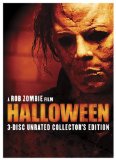| Reviews & Columns |
|
Reviews DVD TV on DVD Blu-ray 4K UHD International DVDs In Theaters Reviews by Studio Video Games Features Collector Series DVDs Easter Egg Database Interviews DVD Talk Radio Feature Articles Columns Anime Talk DVD Savant Horror DVDs The M.O.D. Squad Art House HD Talk Silent DVD
|
DVD Talk Forum |
|
|
| Resources |
|
DVD Price Search Customer Service #'s RCE Info Links |
|
Columns
|
|
|
Halloween (2007) - 3-Disc Unrated Collector's Edition
- Rob Zombie
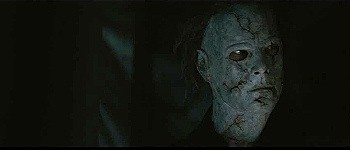
The Movie
When it was announced that Rob Zombie would be "reimagining" John Carpenter's 1978 classic, a large contingent of horror fans cried foul. It was a polarizing film long before it was even made (much less seen), exciting and angering fans in equal amounts. When it was finally released, plenty of naysayers continued their whining, claiming Zombie had made a mess of the movie and tarnished the legacy of Michael Myers.
Personally, I don't mind remakes. Sure, Hollywood horror has become an uninspiring industry, but I loved The Hills Have Eyes and The Texas Chainsaw Massacre reboots, and I'm positively giddy to see the 2009 versions of My Bloody Valentine, Friday the 13th, The House on Sorority Row and Last House on the Left. So in October of 2007, I was in the excited camp to catch Zombie's new take, especially considering my love for the franchise. While Friday the 13th will always be my favorite series, the original Halloween--along with Black Christmas--is the king of all slashers.
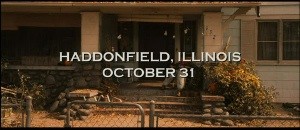
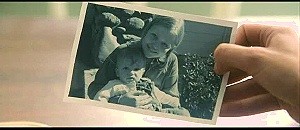
So where does Zombie's version fit into the Halloween collection? Is it a masterpiece like the original, or maybe a respectable entry like parts II, 4 and H20? Is it a guilty pleasure you can't help love like the Myers-less Halloween III (long dismissed by series diehards, the mean-spirited film gets better with age)? Or is it a complete mess like parts 5, 6 and Halloween: Resurrection (the worst and most recent entry in the series)?
For me, the film falls into the respectable group. It isn't the stunning new vision it could have been, but when all is said and done it's a well-made, vicious film that has plenty of thrills. Zombie's take unfolds in three acts: Part 1 takes us inside the Myers household, where young Michael (Daeg Faerch) starts to show signs of unhealthy behavior, partly the result of his abusive, dysfunctional family (think The Jerry Springer Show uncensored times 1,000). While he's shown nothing but love by mom Deborah (Sheri Moon Zombie), Michael finds himself the object of teasing from his sister Judith (Hanna Hall) and his stepdad (William Forsythe). The young boy finally cracks on Halloween night, and the sequence ends with the brutal crime that started the original film.
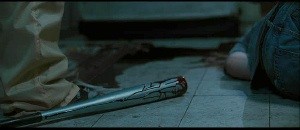
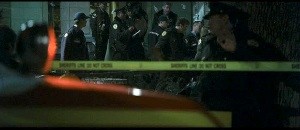
In Act 2, Zombie focuses on Michael's incarceration--and attempted rehabilitation by Dr. Sam Loomis (Malcolm McDowell)--in Smith's Grove Sanitarium. We soon jump 15 years ahead, where the young man has grown into a massive, silent beast (now played by Tyler Mane) who eventually makes his violent escape. That takes us to Act 3 and back to Haddonfield, Illinois, where the rest of the film comes close to mirroring the original, thus inviting the most comparison (Zombie also adds an important plot development from Halloween II). High school gal pals Laurie (Scout Taylor-Compton), Annie (Danielle Harris, who had a lead role in Halloween 4 and 5) and Lynda (Kristina Klebe) soon become Michael's prey on Halloween night.
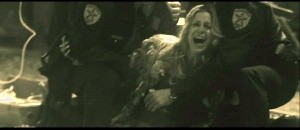
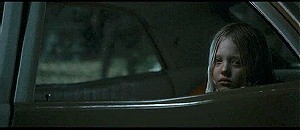
Zombie's vision is a raw, harsh assault on the senses, a brutal entry shot is a few different styles that keep you on edge. Whereas Carpenter was smooth as silk, Zombie is frequently frenetic. Looked at on its own merits, the film is one of the better horror entries of the last few years from a style perspective, and I love watching some of Zombie's shots, which constantly engage your eyes. From the beautiful fake freeze-frame sequence at the end of Act 1 (where the police arrive at the Myers' house) to the final shot of a young Michael's carnage in the woods to the slow-motion alarm scene at the sanitarium to the last scene with Deborah, Zombie is a master at creating visceral images that are strikingly violent yet oddly beautiful and poetic.
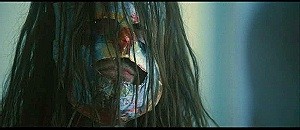
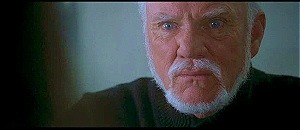
But I got the feeling that the director was under a lot of pressure, and perhaps didn't have a clear enough idea of what he wanted to do--resulting in him trying to do too much. Some of my criticisms of the film may be unfair given my expectations (knowing how talented Zombie is, and given my love for the original). But it feels like Zombie is in a rush, squeezing in enough footage for two full films and never allowing this one to really breathe. (What's with the random "Trick or Treat" title card near the 1-hour, 8-minute mark, by the way?)
This Halloween becomes more rushed at the end, and some of the stalking sequences lack any suspense because they're so routine and fast. I thought there had to be an editing glitch in the see where Dee Wallace (as Laurie's mom) first spots Michael. In the audio commentary, Zombie notes he cut footage at the beginning of the scene (it should have been included) and also tacked on footage filmed later to try and give closure to the scene; but it all just feels off.
In addition, you barely even see the face of Annie's boyfriend Paul (Max Van Ville) near the end, a murder so quick that you couldn't care less about the victim, or be scared ("We didn't realize it at the time, but we really don't ever get to see him much," says Zombie). We aren't given enough time to know the characters we love from the original, and that hurts the finale's impact. I would have preferred a little more time for the final third, and tightened up the first two acts (actually, I would have preferred two movies--a prequel and a remake of the original).
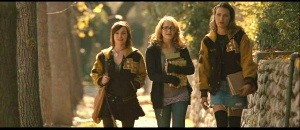
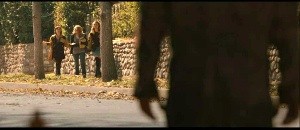
But Zombie has a clear love and appreciation for horror, and you'll see plenty of nods to Carpenter and the original (I also loved the inclusion of "Mr. Sandman", one of the more effective touches from Halloween II). I appreciate his casting, even if it's a little overdone--small roles for the likes of Wallace, Ken Foree, Udo Kier and Sybill Danning (Adrienne Barbeau's scene didn't make the final cut) show that the director appreciates the genre. Although I was disappointed that, for whatever reason, Nancy Stephens--the wife of Halloween II and Resurrection director Rick Rosenthal who appeared in three of the franchise's films including the original--wasn't here. She would have been a great inclusion.
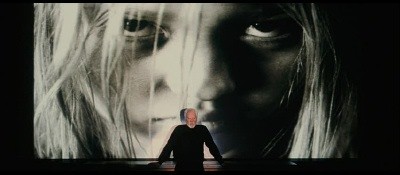
As for the main roles, I was most pleased with McDowell--the absolute perfect choice for Dr. Loomis. The actor couldn't do any better, alternating his cool, cocky and charming persona with a sense of genuine fear, desperation and urgency (he's a little less crazy than the equally great Donald Pleasance was in the role). I also loved Brad Dourif as Annie's sheriff dad, an against-type casting decision that works wonderfully; he spars perfectly with McDowell.
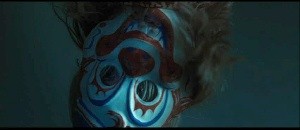
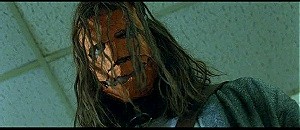
Zombie's wife Sheri is the heart of the film, a true accomplishment considering Deborah won't win any Mom of the Year awards. While I thought there was a little too much shouting in the beginning (the whole Myers family was an a study in angry exaggeration), Moon Zombie grows into the role after a rocky start and shows a softer, more sympathetic side--a welcome change from her psycho turns in her hubby's House of 1000 Corpses and The Devil's Rejects.
I wasn't as enthralled with Faerch as the young Michael. I didn't quite buy his performance, which wasn't helped by his androgynous appearance (I get that you're a rocker, Rob, but enough of the rocker hair on all the male actors). The script hints to an innocent side of the young character's psyche, but I didn't believe it (either I was wrong, or Faerch couldn't quite pull off what was asked of him). But most importantly, he just wasn't believably menacing to me (see Jacob Kogan in Joshua for a truly creepy kid).
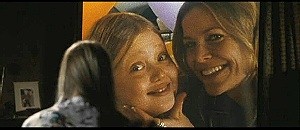
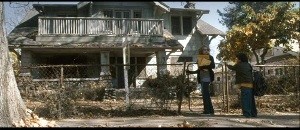
I also found most of the younger characters--including the Myers siblings and the three female amigos--to be a tad irritating, which severely hampered my overall enjoyment of the film. I know kids are smart asses, but the script could have been a little kinder to their characterizations (maybe it's a performance problem). Judith, Linda and even Laurie (more so in her earlier scenes) are excessively--and unnecessarily--annoying. What's the point? It just helps point out that the three main friends don't have the same natural chemistry the original actresses created. (When Annie asks young Lindsay "You know how annoying you are?", I wondered if it was an apologetic acknowledgement.)
Mane is a towering presence who strikes believable fear into the characters and the audience, but I sometimes felt the older Michael was distractingly big, taking away from the killer's calm yet deadly presence. I also think Zombie shows us a little too much of him (and the mask), especially in the third act--diminishing the effect of his stature and visage. Jaws was so successful because we didn't see the shark for a long time, and when we finally did it was sparse. Here, we see too much throughout (I also felt that Carpenter's legendary score was awkwardly introduced into this film, a throwaway use that had no impact).
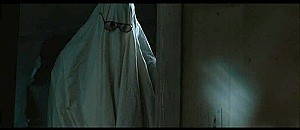
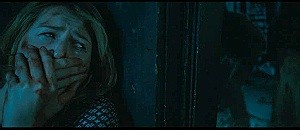
And while I realize that boobs are an essential ingredient for many slasher fans, this film bothered me a little with its treatment of some female characters. That may be the uncomfortable vibe Zombie was aiming for (mission accomplished), and maybe I'm strangely sensitive with this film. But one of my biggest problems here was the lack of respect for the Annie and Lynda characters (made popular by Nancy Loomis and P.J. Soles). They aren't given much to do or say, and Klebe's lasting impression is her landing strip. And do we really need to see talented franchise vet Harris (who, like Wallace, is underused here) topless and stabbed in pointlessly exploitative fashion? Is that cheap thrill really necessary? Doesn't she--and Annie--deserve better?
Still, Zombie is a genuine talent with a love of the genre, and I know I'm being more critical and picky than usual. I just wish the film slowed down and had a tighter, more pointed focus and flow, and a little more heart. If I allow myself to step outside my Halloween frame of reference, this remake becomes a far more enjoyable experience. It's top quality from top to bottom from a technical perspective--it looks and feels real and raw, a haunting story brought to life with quality production values and solid acting. It's angry, aggressive and artistic, and made by people who care about their craft. While this version doesn't match the original, it's still a good yet flawed film that is an exercise in style over substance.
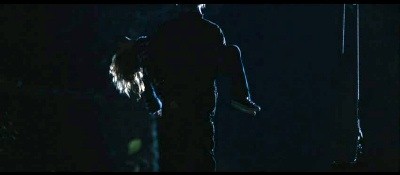
This new 3-disc unrated collector's edition adds a new four-hour documentary on a third disc; the other two are the exact same discs as the 2-disc Unrated Director's Cut released in December of 2007. That means that the prison escape scene with Bill Mosely and Leslie Easterbrook (the biggest difference between this and the theatrical cut) is not here; a shame, especially because I prefer that sequence to the rape sequence scene included here.
The DVD
Video:
In the behind-the-scenes footage, Zombie notes how he intentionally played with the film's look, shooting with various cameras and using digital color timing to manipulate the film subtly, slowly draining color to make it colder. The film--presented in a solid 2.35:1 anamorphic widescreen transfer--is frequently de-saturated to take out natural greens, and often has a cold green tint or warmer brown. If you can accept that, a great image awaits. It's darkly crisp, and achieves exactly what Zombie was going for.
Audio:
The 5.1 track is also crisp and clear, and thankfully doesn't overdue it like so many horror films. It's still aggressive and loud, but doesn't drown out your ears in harsh cues. The dialogue and score are, for the most part, nicely balanced, and the rear channels are effectively used. Subtitles are available in English and Spanish.
Extras:
Before we get into the meaty extras, I have to express my dismay that despite this new, seemingly comprehensive release, the theatrical cut of the prison escape scene with Bill Mosely and Leslie Easterbrook is not here (to frustrate you even more, you can catch very quick glimpses of it in the extras). The only way you can see that is by buying the theatrical cut release from 2007. At the very least, why not just make this a four-disc set and throw that in as well?!
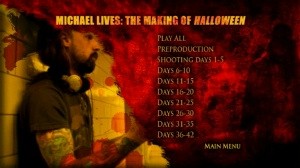
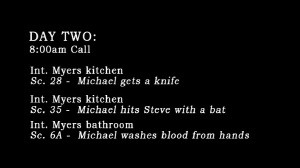
But I digress. There's only one new feature in this collection, but it's a doozie: Michael Lives, a 4-hour, 19-minute documentary housed on its own disc. The exhaustive behind-the-scenes feature is broken into daily segments, from preproduction through all 42 days of filming (including the five days of reshoots that occurred three months after initial filming had concluded). The footage is viewable as one feature or in eight segments (most of them grouped into five-day chunks), and each day has anywhere from two to six scenes being filmed. Michael Lives is comprised of footage of the cast and crew at work as they prepare for scenes interspersed with interviews on set, in a studio and on press junkets.
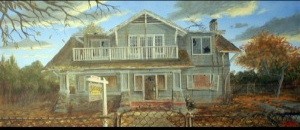
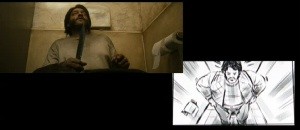
It's a fascinating watch that covers almost every stage of development, from scouting locations to casting, from set design/construction to costume creation (watch Zombie put long-hair wigs on all his male actors!), from props (lots of fall leaves transform California into the Midwest) and special effects to the script (Zombie likes to keep the dialogue fluid) and finishing touches on the score (the editing process isn't given its due here). "I would rather do original stuff, but sometimes, some things just comes along that were such big films to you," Zombie shares early on. "It's like doing Frankenstein or something. Someone's handing you this sort of iconic monster, and allows me to completely reinvent it."
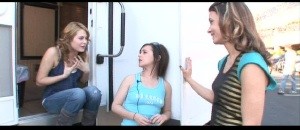
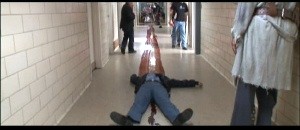
There's so much stuff on display here that it's impossible to give it justice in print. Little details (like Zombie's ringtone or the revelation that Malcolm McDowell never saw the original Halloween) pop up throughout, making for an expansive, informative and detailed look at not only the movie but the filmmaking process. The preproduction segment is one of my favorites (I actually think it could have been even longer!), including segments from a table read with the entire cast and some casting thoughts from Zombie (there is very minor repetition here with the other extras previously released, with a few quotes being used again).
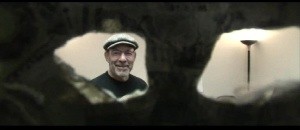
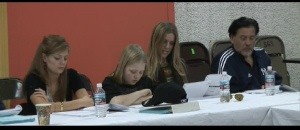
A few of the gory effects are explored, including William Forsythe's unfortunate demise and the aftermath of the Strode household massacre ("In my entire history of doing horror films, I have never been covered with so much blood as I was one day on this set!" laughs Dee Wallace). "People go, 'Oh, are there inventive kills?" I go, 'No, there aren't.' It's not like he electrocutes him or chops his head off," Zombie says of Myers. "I hate that stuff. That's not what's going to happen. The scariest thing you see is when you're watching the news and there's like the 7-Eleven security video, and a guy tries to rob the place and beat another guy to death with a baseball bat. That's always scarier."
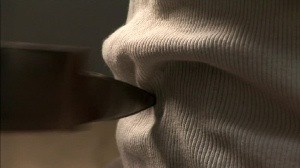
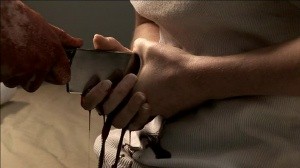
Day 9 has a look at Zombie's beautiful freeze-frame shot, and the most interesting segments are the final reshoots, which have some pretty energetic moments (including the theatrical version of the sanitarium escape scene that isn't presented here). Zombie's attention to detail will give you a new appreciation of the film, and it's nice to see the love that the cast and crew has for the director and the film--everyone here is working hard and wants to do a good job.
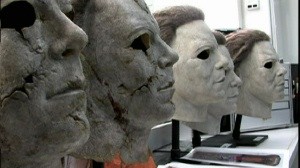
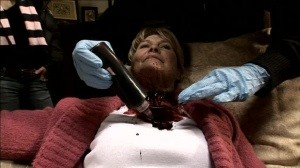
Tyler Mane comes across as a giant puppy dog, so if you want to maintain that creepy image of Michael Myers, you might need to look away. It's fun to see him shoot his scene with Ken Foree ("You were definitely the hardest kill!") and bond with Scout Taylor-Compton, and it's also great to see McDowell crack the cast and crew up (Sherri Moon Zombie, who comes across so kind, caring and genuine, is a frequent target of McDowell's jokes). But it's Sybil Danning who provides the quote of the documentary during her brief yet painful scene with tableware ("I've never been forked before...").
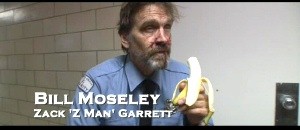
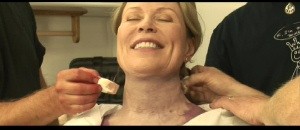
"I like everything to be kind of raw. I like everything to be edgy. All the characters have some edge to them, even the little kids, because I kind of don't like wishy-washy people or situations," Zombie says (although I think he still went a tad too far with the idea). "I kind of tend to lean more towards actors that are a little nuts...I vibe with them better."
The film disc has an audio commentary with Zombie, in which he warns right off the bat: "I am going to talk non-stop through the entire movie." And boy he sure does, sharing a ton of information about things small (the bully kid was in the film Spy Kids; William Forsythe's wig didn't fit; disguises for palm trees) and big (including pointing out some of the footage that was cut from the theatrical cut, including Sybil Danning's insult to young Michael and Ken Foree's Cool Hand Luke tribute). Zombie seems to indicate that a few other scenes were cut (and don't appear in either version), and notes that he had an elaborate opening credit sequence that he didn't use (a shame, because that would have worked much better with Carpenter's theme, which is instead misused over the woods stalking sequence).
A lot of the information he shares is also relayed in other parts of the bonus features, but a lot of it is fresh. Zombie points out when Daeg Faerch's stunt double (a woman) was used ("Obviously I couldn't have a 10-year-old fondling Hanna Hall, so all the hands are stunt hands"), and which of the shots are inserts (usually special effects). He also has fun talking about the bathroom stall showdown between Michael and the truck driver ("Ken is an amazing actor, but he is the worse dead body ever"). Comments about sets, props, effects, dialogue and characters/actors come non-stop in the track, which provides plenty of trivia fodder for fans (which makes up for Zombie's monotone delivery, which may get a tad tiresome). He also notes he tried to tone down the bitchiness of Klebe's Lynda, which I don't think was successful.
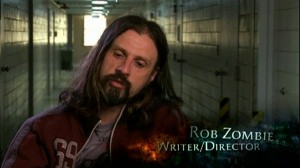
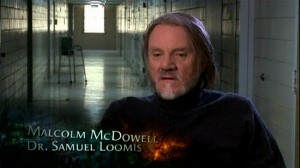
The extras on Disc 2 are also spillovers from the 2-disc Unrated Director's Cut from 2007, a fine collection of material. First up are 17 deleted scenes (totaling 21:56) with optional commentary from Zombie. They provide a few interesting watches--but also show the director made a few changes and altered the film (proving he perhaps wasn't quite sure of what he wanted). A lot of the material here is boring (including Adrienne Barbeau's quick scene and a few too many filler conversation scenes between Loomis and Deborah outside the sanitarium), but four of them stand out: "Night Shift" is my favorite, a great sequence during Michael's escape from the sanitarium with a few chilling shots. Zombie says it didn't quite fit, but I wish he found a way to include it. "Tombstone" (featuring another awkward title card) features a graveyard kill, but Zombie rightly decided that having Michael out in the daylight demystified him. "Missing Stone" is an alternate take between Loomis and the sheriff that I preferred, while "Van Kill" is an alternate murder scene that I'm glad they left out--instead opting to pay tribute to a kill in the original featuring one of its most memorable shots (why they thought they wouldn't use that, I have no idea).
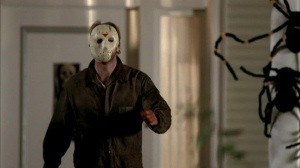 The alternate ending (3:43) brings the film to a quicker conclusion, and Zombie decided to ditch it in favor of a sequence that gave Laurie more to do. There's a poetic nature to this scene that I dig, but the more exciting ending they used was probably the right choice. The bloopers (10:16) are a fun watch that mostly revolves around McDowell cracking up his co-stars (sometimes to the annoyance of the filmer: "We've gotta get through this...don't make him laugh!"). His taunting of Udo Kier is tasteless but funny, which is probably why McDowell asks at the end: "Do you think the Weinsteins will see the dailies? If they do, I'm fucked." (Also watch for a shout-out to another famous slasher!)
The alternate ending (3:43) brings the film to a quicker conclusion, and Zombie decided to ditch it in favor of a sequence that gave Laurie more to do. There's a poetic nature to this scene that I dig, but the more exciting ending they used was probably the right choice. The bloopers (10:16) are a fun watch that mostly revolves around McDowell cracking up his co-stars (sometimes to the annoyance of the filmer: "We've gotta get through this...don't make him laugh!"). His taunting of Udo Kier is tasteless but funny, which is probably why McDowell asks at the end: "Do you think the Weinsteins will see the dailies? If they do, I'm fucked." (Also watch for a shout-out to another famous slasher!)
The Many Masks of Michael Myers (6:26) takes a look behind the character's psyche. "I wanted to bring something a little more to the role than just a walking shape. I feel that it's scarier to know a little bit about what's going on behind the mask than just the mask," says Mane, who watched Faerch's performance to get into the character. Makeup FX artist Wayne Toth also talks about creating the masks.



Re-Imagining Halloween is a collection of three behind-the-scenes segments. In "From Camera to Screen" (6:08), Zombie talks about how he wanted to stay respectful to the original while still giving it his own spin ("for good or for bad, it's a totally different experience"), while other crew members emphasize the director's vision--and his desire to keep the film realistic. Zombie and director of photography Phil Parmet talk about using the visual style of films like 21 Grams, Amores Perros and The Constant Gardener to set the film apart from the original (and Carpenter's style). Zombie notes he used handheld cameras in Act 1 for a rough, raw feel, then went more stylized in Act 2 in the sanitarium--using locked-down cameras for a symmetrical, sterile look that dwarfed the characters in their surroundings. Act 3 necessitated Steadicams and dollies for a more smooth look before reverting back to the handheld style for the end of the film.



In "The Production Design" (5:33), Anthony Tremblay talks about how he worked with Zombie to develop the look of the film, emphasizing his challenges in developing the Myers house, the basement set, the Rabbit in Red strip club and the sanitarium. In the final segment, "The Makeup FX, Props and Wardrobe" (7:17), crew members talk about their contributions. Toth and prop master John Brunot share some knife and kill tricks, while costume designer Mary McLeoud talks about the '70s influence on the film--and how she helped create the infamous overalls.
In Meet the Cast, Zombie talks about 12 cast members (many who have worked with the director before), who also chime in: Malcolm McDowell, Daeg Faerch, Tyler Mane, Sheri Moon Zombie, Scout Taylor-Compton, Danielle Harris, Kristina Klebe, Brad Dourif, Dee Wallace, Danny Trejo, Lew Temple and Sid Haig. It's a nice tribute to the cast, although I wish some had more time to speak (of Wallace, Zombie says "she's so immediately likeable on screen, and so sympathetic"). McDowell shares how he knew Donald Pleasance, but never watched the original for fear of picking up any influenced mannerisms. Mane notes how he's the tallest, biggest Michael ever, and that he wanted to do more than just lumber around. Compton shares how she "put a lot of Scout" into Laurie, making her "more spunky" and giving her attitude. Says Zombie: "She was like, 'Don't make me like Jamie Lee Curtis!' because it's like, it doesn't seem real anymore. Maybe 30 years ago it seemed real, but if I made her like Jamie Lee Curtis was in John Carpenter's, she would have seemed like she was like Amish or something...even the nice kids have attitude." (For my taste, it was a little too much; I'll take Jamie Lee's Laurie any day...)
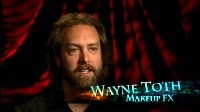
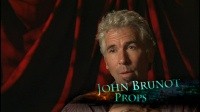
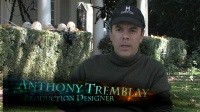
The casting sessions segment (29:50) is lower quality screen-test footage of actors reading (and sometimes re-reading) lines. It's a tad repetitive and boring, but you get some principal cast members (Faerch, Taylor-Compton, Harris, Klebe, Harris) and a lot of bit role players: Adam Weisman (Judith's boyfriend), Skyler Gisondo (Tommy), Jenny Stewart (Lindsay), Daryl Sabara (the school bully), Pat Skipper (Laurie's dad), Clint Howard (the school principal), Nick Mennell (Lynda's boyfriend Bob), Mel Fair (the newsman) and Courtney Gaine (who I think is only in the director's cut). But my favorite clip comes from Max Van Ville, who plays Annie's boyfriend Paul. Not only is he given more screen time here, but you can actually see his face (unlike in the film)--but even better, he also shows off his sex face acting skills for his orgasm scene (!).
You also get a similar feature, the Scout Taylor-Compton Screen Test (7:45), which has the actress reading lines with Harris and other crew members (including some challenging, emotional scenes). There's also footage of her performing a scene with Harris and Klebe. Rounding out the package is the film's theatrical trailer, and trailers for other releases.
Final Thoughts:
How can you make a classic better? You can't, but Rob Zombie gives it a solid try with his vision of Carpenter's iconic film. Given my high regard for the original and my expectations of Zombie's talent, I was a tad disappointed. It just feels like the director wasn't quite sure what he wanted to do, and ended up trying to do too much. But if you can step outside that 1978 Halloween frame of reference, a solid horror film awaits. It succeeds with style, not substance--too many characters are far too annoying to care for. But the film is made with top-notch production values and a talented cast, and still manages to create and sustain an unnerving energy that keeps you uncomfortable. Throw in an amazing set of extras--including the new, 4-hour documentary (the only new material here)--and this comes easily Recommended.
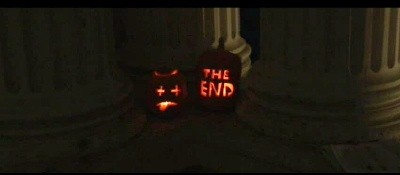
|
| Popular Reviews |
| Sponsored Links |
|
|
| Sponsored Links |
|
|
| Release List | Reviews | Shop | Newsletter | Forum | DVD Giveaways | Blu-Ray | Advertise |
|
Copyright 2024 DVDTalk.com All Rights Reserved. Legal Info, Privacy Policy, Terms of Use,
Manage Preferences,
Your Privacy Choices | |||||||









